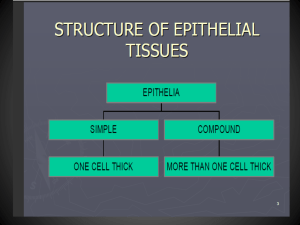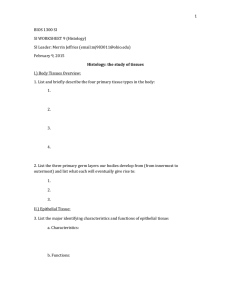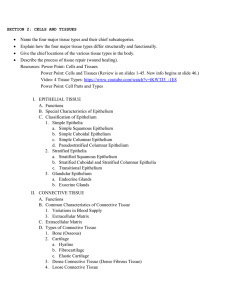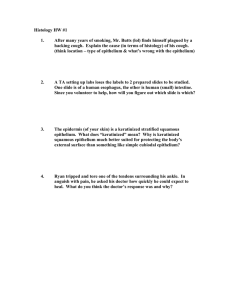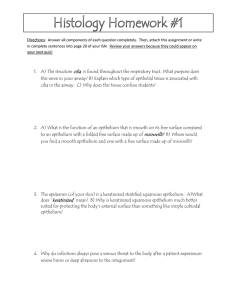LAB #2
advertisement
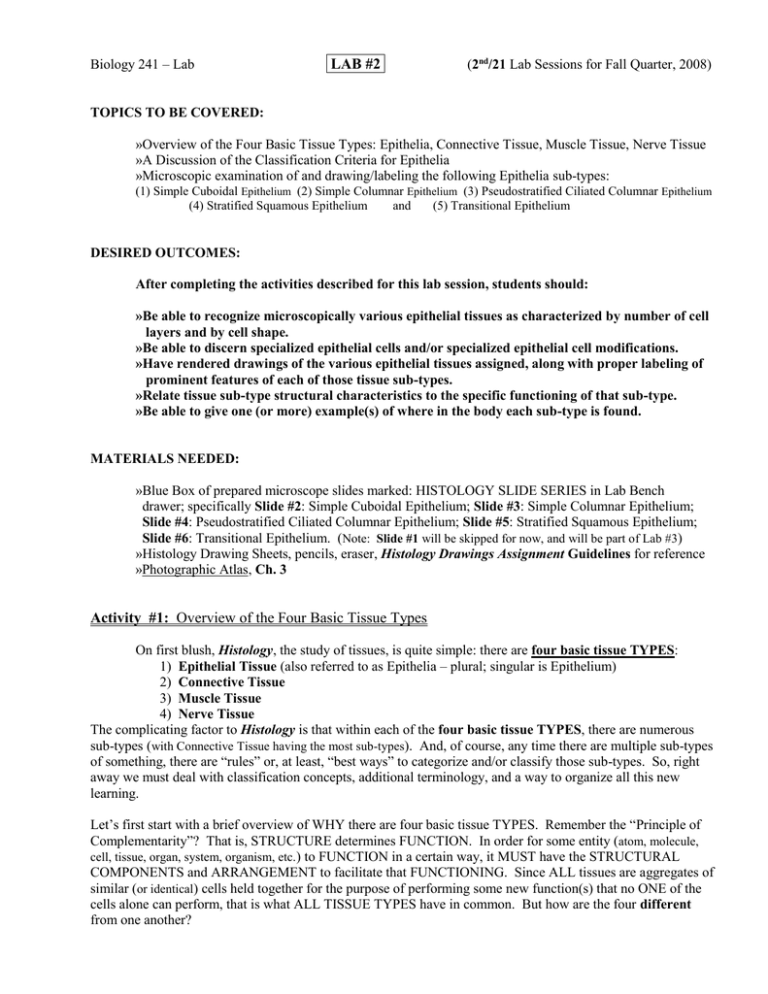
Biology 241 – Lab LAB #2 (2nd/21 Lab Sessions for Fall Quarter, 2008) TOPICS TO BE COVERED: »Overview of the Four Basic Tissue Types: Epithelia, Connective Tissue, Muscle Tissue, Nerve Tissue »A Discussion of the Classification Criteria for Epithelia »Microscopic examination of and drawing/labeling the following Epithelia sub-types: (1) Simple Cuboidal Epithelium (2) Simple Columnar Epithelium (3) Pseudostratified Ciliated Columnar Epithelium (4) Stratified Squamous Epithelium and (5) Transitional Epithelium DESIRED OUTCOMES: After completing the activities described for this lab session, students should: »Be able to recognize microscopically various epithelial tissues as characterized by number of cell layers and by cell shape. »Be able to discern specialized epithelial cells and/or specialized epithelial cell modifications. »Have rendered drawings of the various epithelial tissues assigned, along with proper labeling of prominent features of each of those tissue sub-types. »Relate tissue sub-type structural characteristics to the specific functioning of that sub-type. »Be able to give one (or more) example(s) of where in the body each sub-type is found. MATERIALS NEEDED: »Blue Box of prepared microscope slides marked: HISTOLOGY SLIDE SERIES in Lab Bench drawer; specifically Slide #2: Simple Cuboidal Epithelium; Slide #3: Simple Columnar Epithelium; Slide #4: Pseudostratified Ciliated Columnar Epithelium; Slide #5: Stratified Squamous Epithelium; Slide #6: Transitional Epithelium. (Note: Slide #1 will be skipped for now, and will be part of Lab #3) »Histology Drawing Sheets, pencils, eraser, Histology Drawings Assignment Guidelines for reference »Photographic Atlas, Ch. 3 Activity #1: Overview of the Four Basic Tissue Types On first blush, Histology, the study of tissues, is quite simple: there are four basic tissue TYPES: 1) Epithelial Tissue (also referred to as Epithelia – plural; singular is Epithelium) 2) Connective Tissue 3) Muscle Tissue 4) Nerve Tissue The complicating factor to Histology is that within each of the four basic tissue TYPES, there are numerous sub-types (with Connective Tissue having the most sub-types). And, of course, any time there are multiple sub-types of something, there are “rules” or, at least, “best ways” to categorize and/or classify those sub-types. So, right away we must deal with classification concepts, additional terminology, and a way to organize all this new learning. Let’s first start with a brief overview of WHY there are four basic tissue TYPES. Remember the “Principle of Complementarity”? That is, STRUCTURE determines FUNCTION. In order for some entity (atom, molecule, cell, tissue, organ, system, organism, etc.) to FUNCTION in a certain way, it MUST have the STRUCTURAL COMPONENTS and ARRANGEMENT to facilitate that FUNCTIONING. Since ALL tissues are aggregates of similar (or identical) cells held together for the purpose of performing some new function(s) that no ONE of the cells alone can perform, that is what ALL TISSUE TYPES have in common. But how are the four different from one another? Biology 241 – LAB #2 – continued Page Two »EPITHELIAL TISSUE: is specialized to overlay any body surface; that is, it COVERS external body surfaces and it LINES internal body surfaces. ALL BODY SURFACES are associated with one of the Epithelia. Epithelial cells as adapted to protect, absorb, secrete, and specialize in other ways such as giving rise to glands, and becoming parts of sensory receptors. (Important factoid: ALL GLANDS derive from Epithelia) »CONNECTIVE TISSUE: is specialized to connect one tissue type to another; to support, protect, pad, and insulate. Most abundant and diverse tissue type in the body (having the most sub-types). »MUSCLE TISSUE: is specialized to contract, thus allowing for movement and motion, and its activity contributes directly to heat production – thus body temperature maintenance. »NERVE TISSUE: is specialized to generate and conduct impulses; that is, turn reception of stimuli into chemical / electrical signals that can be routed (sent along neural pathways) for maximally efficient communication of body needs. Functionally then, these are the ways in which the four basic tissue types differ from one another. They also differ in the way(s) that their sub-types are classified. Let’s now look at the WAYS TO CLASSIFY tissue subtypes. Activity #2: A Discussion of the Classification Criteria for Epithelia »EPITHELIAL TISSUE: is classified according to two distinct criteria: (1) Cell Shape and (2) Number of Layers (of cells) a. Squamous (“flat” Squame (Gr) = fish scale) a. One single layer = Simple (or non-stratified) b. Cuboidal (“cube-shaped”; as wide as tall as deep) c. Columnar (“tall + thin”; much taller than wide/deep) b. Two or more layers = Stratified Combining the two entries under heading (2) with the three entries under heading (1), SIX possibilities result: 1. Simple Squamous epithelium 4. Stratified Squamous epithelium 2. Simple Cuboidal epithelium 5. Stratified Cuboidal epithelium 3. Simple Columnar epithelium 6. Stratified Columnar epithelium There are two additional epithelial tissue sub-types that are referred to as “intermediate” because they do not fit into the above “strict” classification scheme. These are: 7. Pseudostratified, Ciliated, Columnar epithelium* 8. Transitional epithelium** Putting all of the above together then, there are eight sub-types of Epithelia. * Pseudostratified Ciliated Columnar epithelium is truly a “simple” epithelium because it consists of a single layer of cells, all of which touch the basement membrane, but NOT all of which reach the lumen. ** Transitional epithelium is truly a “stratified” epithelium because it consists of several layers (5 – 8) of cells, but not all cells have the same shape. The single basal layer consists of cells that are cuboidal; the next several layers consist of cells that are polygonal; and the apical-most layer consists of cells called “balloon cells” that are quite rounded when the urinary bladder is empty- but these same cells become broadly squamous as the bladder fills. Thus, the apical-most cells “transition” between rounded and squamous. Biology 241 - LAB #2 – continued Page Three Of the eight sub-types of Epithelia, you are required to draw only six of them (all but Stratified Cuboidal epithelium and Stratified Columnar epithelium. Each of these two sub-types is found only in very confined locations, and thus much more transient than the others.) While examining and drawing the six required epithelia, here are a few generalized characteristics to keep in mind: 1. All epithelia exhibit dense “cellularity” – that is, they consist of tightly-packed cells with little or NO intercellular spaces or intercellular substance. In fact, the term “epithelium” derives from a Greek word epithelios meaning “fabric”. What epithelial tissues have “going for them” is that they form continuous, uninterrupted, strong sheets that are very effective in NOT allowing passive penetration. 2. All epithelia exhibit “polarity” – that is, there is a strict directionality to the tissue: there is always an apical surface and a basal surface. The apical surface of the epithelial cells, or the apical orientation of the tissue, refers to that surface closest to or in contact with the lumen (interior) of a hollow structure. The basal surface of the epithelial cells, or the basal orientation of the tissue, refers to that surface closest to or in contact with the Basement Membrane – a very important acellular structure which is considered to belong to the epithelial tissue. *See #4, #5 below. (Your text gives a very nice explanation of the nature and function of the Basement Membrane and its two sub-components: the superficial basal lamina, secreted by the epithelial cells; and the deep reticular lamina, secreted by the connective tissue cells underneath. This acellular structure serves as an area of attachment and support for the overlying epithelium, and it helps regulate passage of important nutrients and regulatory molecules to the avascular* epithelial tissue.) 3. All epithelia are avascular – that is, they lack blood vessels. There is no direct blood supply; therefore, water, nutrients, vitamins, minerals, and other substances must diffuse across the Basement Membrane to the epithelial cells from the nearest blood vessels: the capillaries in the underlying connective tissues. 4. There is always a “free edge” – that is, the apical surface of the tissue touches a lumen of a hollow structure (ie lumen of thyroid follicle; lumen of small intestine, trachea, urinary bladder, etc.) if the epithelium lines an inner surface; or there is space above the tissue if it covers an external surface (ie such as the epidermis of the skin). 5. There is always a “basal surface” – that is, the layer of cells (in a stratified epithelium) or the surface of cells (in a simple epithelium) that touch the Basement Membrane. 6. Functionally speaking, epithelia are either protective, absorptive, secretory, or specialized (ie such as Pseudostratified, Ciliated, Columnar epithelium which is specialized to both secrete mucus and to move mucus-entrapped particulate matter uni-directionally upward toward the oropharynx to be swallowed. ) Activity #3: Microscopic examination of/drawing/labeling of assigned Epithelial tissue sub-types For today, you will examine and generate labeled drawings for Slides #2 - #6 representing the following five epithelia sub-types: (1) Simple Cuboidal epithelium, (2) Simple Columnar epithelium, (3) Pseudostratified Ciliated Columnar epithelium, (4) Stratified Squamous epithelium and (5) Transitional epithelium. *Note: you will NOT start with Simple Squamous epithelium as it is a sub-type that is a bit more difficult to distinguish. It is best to give yourself some time to practice your microscopy techniques, to hone your powers of observation of cellular details, and to discover the discernable characteristics of epithelial tissues that are much more obvious. Lab #3 will present some special “pointers” for locating and examining Simple Squamous epithelium.

